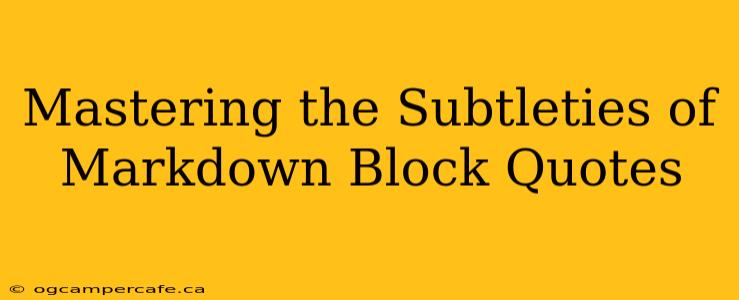Markdown's block quote functionality, while seemingly simple, offers a surprising depth of stylistic control and semantic meaning. Mastering its nuances can significantly enhance the readability and impact of your writing, whether you're crafting technical documentation, a compelling blog post, or a captivating novel. This guide delves beyond the basics, exploring the subtle art of using block quotes effectively.
What is a Markdown Block Quote?
At its core, a Markdown block quote is used to visually set apart a section of text, typically indicating a quotation from another source or a noteworthy passage within your own writing. It's achieved using a > symbol at the beginning of each line. For instance:
> This is a block quote. It's clearly set apart from the surrounding text.
> This allows for improved readability and emphasis.
This renders as:
This is a block quote. It's clearly set apart from the surrounding text. This allows for improved readability and emphasis.
How to Use Nested Block Quotes?
Markdown supports nested block quotes, allowing you to create a hierarchy of quotations. This is particularly useful when quoting multiple sources within a single quote or when representing a conversation. You simply add additional > symbols:
> This is the main quote.
>> This is a nested quote, further indented to show its relationship to the main quote.
>>> And this is a quote nested even further.
This renders as:
This is the main quote.
This is a nested quote, further indented to show its relationship to the main quote.
And this is a quote nested even further.
Can You Use Block Quotes for Emphasis Besides Quotations?
Absolutely! While often used for direct quotations, block quotes are versatile tools for highlighting key points or creating a distinct visual separation. This can be exceptionally useful for providing examples, emphasizing key takeaways, or offering a contrasting perspective. For example:
Key Takeaway: Remember to always back up your data regularly!
This emphasizes the importance of data backups without directly quoting another source.
How to Use Block Quotes with Other Markdown Elements?
Block quotes work seamlessly with other Markdown elements, including headings, lists, and code blocks, extending their formatting capabilities.
> # A Heading Within a Block Quote
>
> * A bulleted list item
> * Another bulleted list item
>
> ```python
> print("Hello, world!")
> ```
This renders as:
- A bulleted list item
- Another bulleted list item
print("Hello, world!")
This showcases the flexibility of incorporating different structural elements within block quotes.
Styling Block Quotes: Adding Attributes and Context
While Markdown itself doesn't offer direct styling options within block quotes (like bolding the entire quote), you can add context and attribution before or after the quote. This allows for greater clarity and professionalism. For instance:
"The best way to predict the future is to create it." - Peter Drucker
This provides context by adding the author's name after the quote.
Are There Any Best Practices for Using Block Quotes?
Yes! Here are some best practices:
- Keep them concise: Avoid excessively long block quotes. Break them up if necessary.
- Provide context: Always clarify the source of the quote or the reason for its inclusion.
- Use sparingly: Overuse can clutter your writing and diminish their impact.
- Maintain consistency: Use a consistent style throughout your document.
By understanding and applying these subtle nuances, you can elevate your Markdown skills and create more engaging, readable, and impactful content. Mastering Markdown block quotes is more than just proper formatting; it's about effectively communicating your message.
